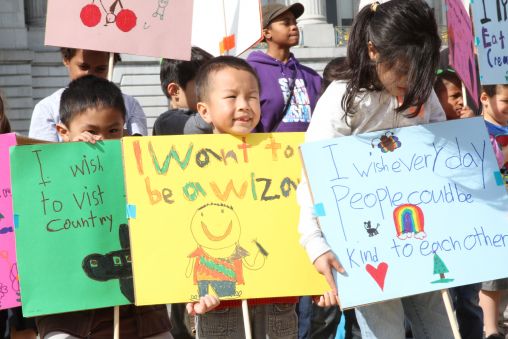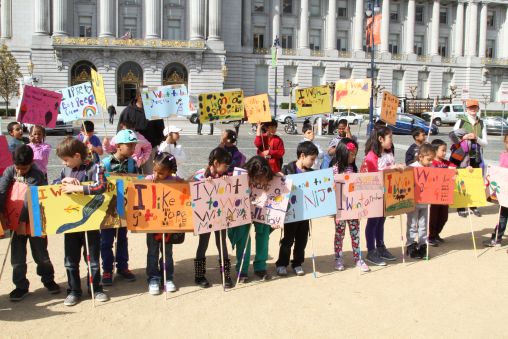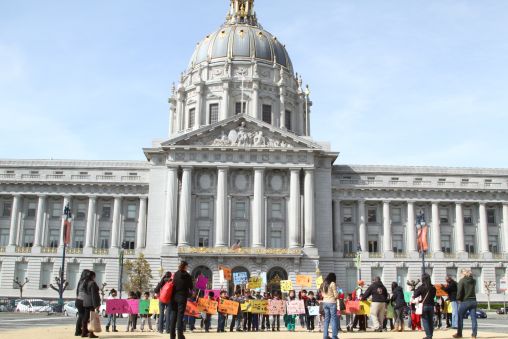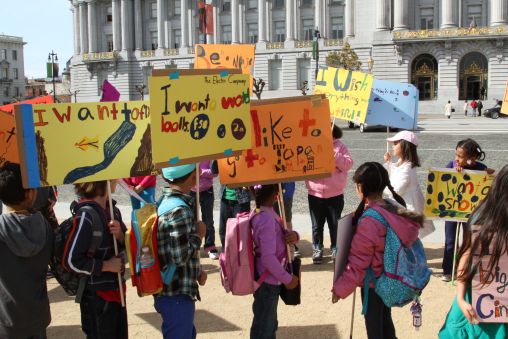Activity
Children’s Pride

Comon Core Standards:
Grade 1 Writing: 1.) Write opinion pieces in which they introduce the topic or name the book they are writing about, state an opinion, supply a reason for the opinion, and provide some sense of closure; Speaking/Listening; 1a.) Follow agreed-upon rules for discussions (e.g., listening to others and taking turns speaking about the topics and texts under discussion); Presentation of Knowledge and Ideas: 1.) Participate in collaborative conversations with diverse partners about grade 1 topics and texts with peers and adults in small and larger groups; 5.) Add drawings or other visual displays to descriptions when appropriate to clarify ideas, thoughts, and feelings.
Content Standards (California): History Social Science: 1.5 Students describe the human characteristics of familiar places and the varied backgrounds of American citizens and residents in those places: Recognize the ways in which they are all part of the same community, sharing principles, goals, and traditions despite their varied ancestry; the forms of diversity in their school and community; and the benefits and challenges of a diverse population; Visual/Performing Arts: Grade 1: 4.2 Identify and describe various reasons for making art; Grade 2: 3.1 Explain how artists use their work to share experiences or communicate ideas; 4.1 Compare ideas expressed through their own works of art with ideas expressed in the work of others; 4.2 Compare different responses to the same work of art.
Materials: colored paper; cardboard (same size as colored paper); double sided tape (to put the colored paper on the cardboard); wooden bar (as handle); colored duct tape (to put the cardboard to the wooden bar); colored markers; camera (optional: video camera); scratch paper and pencils
Procedure:
Preparing the Placards (2 hours)
- Show 5-6 demonstration images from different places and times. Keep the subject of the protest anonymous.
- Tell students that these images show people coming together to make the world better, or to have a better life.
- Prompt: “What do you want to make your life better right now?” Ask students to write down 5-10 ideas.
- Discuss ideas with students to help expand on details and add descriptive language or visuals that support their idea.
- Each student chooses their favorite idea for their placard.
- Distribute a large piece of construction paper to each student to start designing their sign. Tip: Start with pencils and make letter very large.
- Students expand on their message by drawing pictures that reinforce their idea.
- When completed, teachers/helpers can assemble signs by affixing them to the cardboard using double sided tape.
- Affix the placard to the post using duct tape.
- Use colored duct tape to create handles. Keep handles low so signs don’t hit other students during the march.
Extension: Students who finish early can fill a small soda bottle with 5 marbles and tape it to their sign to create sound during the march/chant.
Preparing for the March (20 minutes)
- In your classroom, organize students in number order. They can be in lines or groups as long as they know when it is their turn.
- Call and Response: Each student will yell their wish, and the class will respond. Repeat so each student does this two times until the whole class has had a turn.
- Practice until students are ready to lead the march on their own.
March (30-45 minutes)
- Conduct march at a site of your choice. Students may move as a pack or in any form that they determine so they feel in charge.
- Adults take pictures and video, and monitor traffic safety.
Sharing with the Children’s Pride Community
- Invite students to view their Children’s Pride images and those of other students around the world.
- Explain the motivation for this project (see About Children’s Pride below).
- Discussion: How are the pictures from your march similar or different to others that you have seen?
- Reflection: How did you feel when you were marching?
Lesson by artist and teacher Takayuki Yamamoto.
About Children’s Pride and Takayuki Yamamoto:
Takayuki Yamamoto is a mixed-media artist who satirizes the roles of institutions by facilitating creative experiences that place children in positions of power. With Children’s Pride, Yamamoto critiques collective demonstrations by exposing that through the action of solidarity, individuals lose their agency. The focus of his critique isn’t the function of a demonstration, but rather the tendency of people to join or jump on the bandwagon without clearly understanding the nature of the position/cause they are taking.
Yamamoto prefers to work with children because, “they know what they want, can hear their primal need, and are really flexible. Adults are opposite. They don’t know what they want and aren’t flexible at all. Formal education as a system, imposes and shapes a way of thinking that is based on the past ideas and experiences. This hinders the free thinking that children will need to create the future.”
Yamamoto hopes to instill a sense of self-awareness and advocacy for what individuals want, while encouraging them to celebrate the uniqueness of each student’s individual identity. “Everyone is different and that is good.” Through this collective space, he also hopes to promote a respect for individuality not only in one’s classroom community, but across the world.







